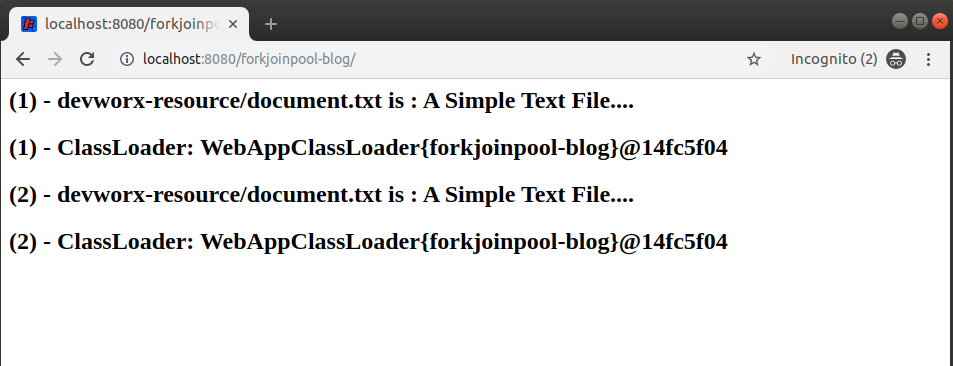Beware - The Java ForkJoinPool in Web Applications.
The behaviour of Java’s ForkJoinPool is not always what it seems when you use it in a web application hosted in Apache Tomcat / Jetty and can lead to some surprising consequences.
In this blog we explore some 'missing classpath resource' issues that can be caused by reliance on the ForkJoinPool Classloader in Web Applications.
The Mystery of the Missing Classpath Resources
Embedding resources in your classpath is a typical way to ensure that you can access important files in a platform-agnostic and to avoid the many idiosyncrasies specific to each operating system implementation.
In addition, you may consider using Java’s built-in ForkJoinPool and not spawn your own thread pool in order to avoid what has been described as the tragedy of the commons.
This can lead to some unforseen consequences, however. Consider the following code example and output:
@WebServlet("/")
public class ForkJoinPoolResourceServlet extends HttpServlet
{
public static final String CLASSPATH_RESOURCE = "devworx-resource/document.txt";
@Override
protected void doGet( HttpServletRequest req,
HttpServletResponse resp) throws ServletException, IOException
{
final PrintWriter writer = resp.getWriter();
writer.write("<html>");
writer.write("<h2>(1) - " + CLASSPATH_RESOURCE + " is : " +
getContent( Thread.currentThread().getContextClassLoader().getResourceAsStream(CLASSPATH_RESOURCE)) +
"</h2>");
writer.write("<h2>(1) - ClassLoader: " +
Thread.currentThread().getContextClassLoader() + // List my class loader
"</h2>");
ForkJoinTask<?> task = ForkJoinPool.commonPool().submit(() ->
{
writer.write("<h2>(2) - " + CLASSPATH_RESOURCE + " is : " +
getContent( Thread.currentThread().getContextClassLoader().getResourceAsStream(CLASSPATH_RESOURCE)) +
"</h2>");
writer.write("<h2>(2) - ClassLoader: " +
Thread.currentThread().getContextClassLoader() +
"</h2>");
});
...
task.get();
..
writer.write("</html>");
}
private String getContent(InputStream ins)
{
try
{
if(ins == null) return "NULL";
else return IOUtils.toString(ins, "UTF-8");
}
catch (IOException e)
{
throw new RuntimeException("Unexpected error ! - " + e, e);
}
}
}First time you load this page, you get:

But then when you refresh - you get the following:

In this relatively simple example this is not an issue. However, as part of a much bigger application and workflow this can cause serious issues.
The Switching of Contexts
From the example above, it is clear that the ContextClassLoader changes over the course of the application’s deployment. And certainly, looking at some of the Tomcat Resources on class loading - it becomes clear why relying on a common pool (which may be loaded as part of the Bootstrap or System ClassLoaders) is best avoided.
This particular nuance proved to be quite a costly delay in the development of my project. Hence an important lesson from this experience:
| Be in control of your own thread pools and classloader contexts. Be aware that behaviour in your test case runtime may be radically different from the behaviour in the runtime of a container. |
Reference Project
For the source code used in this blog, please refer to: https://github.com/DevWorxCo/forkjoinpool-blog
Contact
I would be interested to hear your thoughts on this and other topics. Feel free to get in touch.
